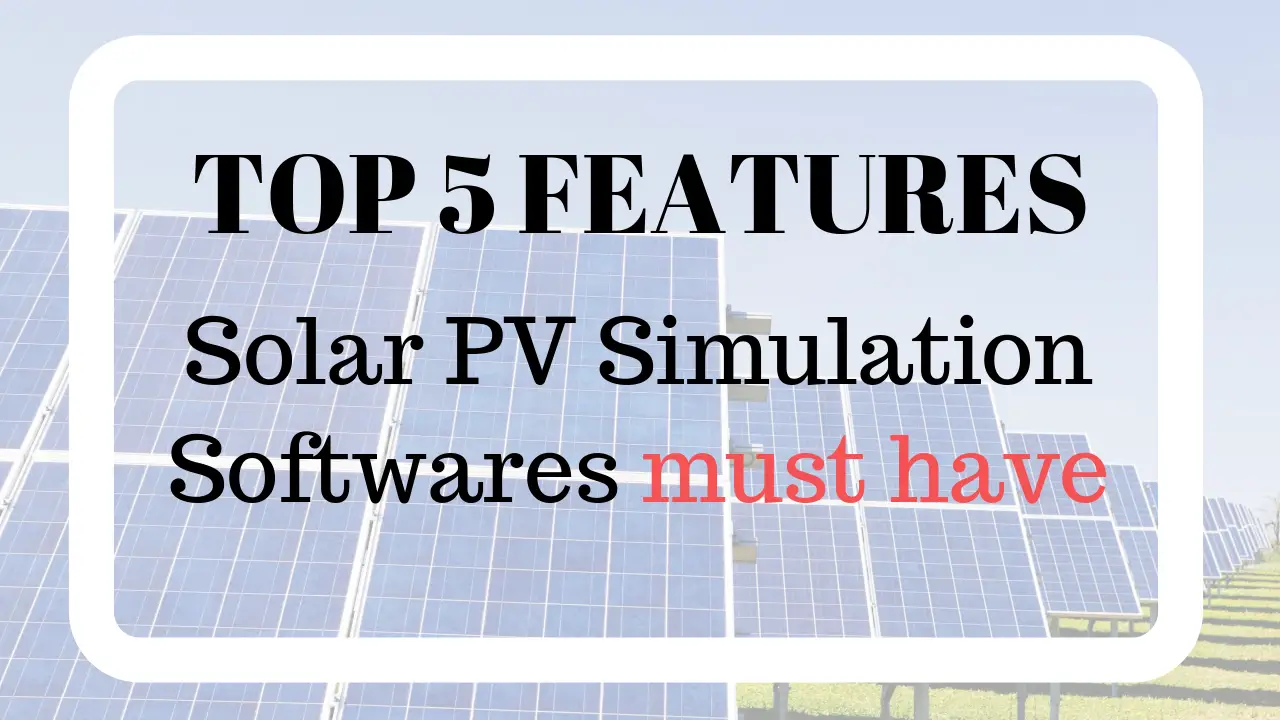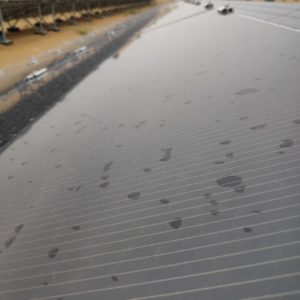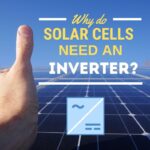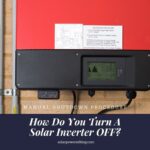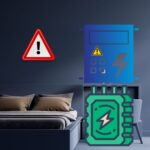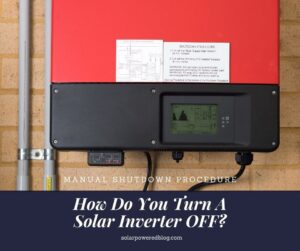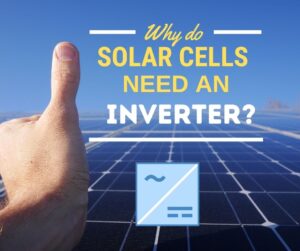To achieve the optimal benefits of harvesting solar energy, choosing an inverter that packs the most useful features is the key. In this article, we will discuss the factors that make a grid-tie solar string inverter the best of its kind.
A solar inverter is a device that converts the DC power from solar panels into AC electricity. It usually has multiple DC inputs that allow the connection of solar PV strings into the inverter’s DC side.
The AC side of an on-grid type inverter (a.k.a. grid-tie solar inverter) directly connects to the local utility grid through the electrical mains of a building. It uses the electrical utility parameters such as voltage and frequency as a grid reference. This enables the inverter to synchronize to the grid and pump power to the connected load.
If you want to learn more about grid-tie solar, you may want to check this article regarding on-grid vs off-grid solar systems.
What is a String Inverter?

A string inverter is simply an inverter that requires a higher level of DC input voltage to operate. It is designed to take 5 to 22 solar panels, connected in series, as its input. Additionally, to learn how to operate and and to switch off an inverter will also be essential.
What’s a Solar Panel String?
The arrangement of the modules on the input side of a string inverter is also known as a string. That obviously gives you the idea of where it gets its name.
Basically, the solar panels’ individual voltages add up when you connect them in series. It applies the same electrical principle with the series-connected batteries.
What is String Inverter Input Voltage?
A solar panel string that produces a voltage level within the inverter’s requirement allows the device to start converting DC electricity into AC. It usually ranges from 200Vdc up to 1000Vdc.
Moreover, newer inverter technology is now capable to take a much higher DC voltage level, like 1100Vdc to 1500Vdc.
What features make the best inverter?
There are a lot of factors to be considered when choosing the best inverter. Although the end-users’ needs might vary, few aspects are commonly desired for the grid-tie inverters to have. Here is a list of important features for an inverter to be considered in the top tier:
- Maximum Efficiency
- High Inverter Load Ratio
- Multiple MPPT (Maximum Power Point Tracking) Inputs
- Cost-Effectiveness
- High Safety and Protection Level
- Ease of Installation
- Connectivity and Monitoring
1. Maximum Efficiency
Maximum efficiency is an important factor that should always be considered when choosing a string inverter. This is as straightforward as it gets. We want our inverter to be the least contributor to the power loss of the solar PV system.
Max efficiency is the level of inverter’s capability in converting solar energy from DC power to AC power efficiently, with respect to the maximum power capacity of the device.
This is usually the first thing people will check when choosing a string inverter. The inverter peak efficiency rating needs to be as close to 100% to be able to optimize the solar energy harvest. At present, the top inverter manufacturers are able to achieve almost 99% maximum efficiency.
As an example, you may want to take a look at the best 10kW inverters list we have in our previous blog post.
2. High Inverter Load Ratio

The inverter load ratio or ILR, which is also known as the DC/AC ratio, is an essential feature that a string inverter could have. This refers to the proportion of the peak power capacity of the solar arrays to the maximum capacity of the inverter they are connected to. It is a fundamental key in optimizing the solar PV system production.
Why is a high DC/AC inverter ratio a good thing?

The average string inverters today provides 1.0 to 1.10 load ratios. These are considered low DC/AC ratios, which may not be that impressive to a lot of people.
However, a top tier string inverter would be able to easily handle a 1.2 – 2.0 load ratio, or even higher. This maximizes the benefits of the dropping prices of solar PV panels. It means you can feed 20% to 100% more PV power to what the inverter is rated to produce. It not only gives more flexibility in the design stage but also, more energy production out of larger PV systems.
Studies show that having a high DC/AC ratio leads to higher energy yield for the solar PV system, especially, for areas where average irradiance is relatively low. (Source)
3. Multiple MPPT Inputs
The more MPPTs an inverter has, the better. Multiple MPPTs in a string inverter is definitely a must-have feature!
What is an MPPT?
Maximum power point tracking (MPPT) is a technique or algorithm used with photovoltaic systems to maximize power extraction under all conditions. It is a computation that the string inverter does, as soon as it senses power from its input terminals.
The maximum power point of a string of PV modules is dynamic in the real world as irradiance, soiling, clouds, module temperature, degradation, and shading contribute to non-ideal operational conditions. MPPT algorithms have evolved over the years, and the most effective algorithms directly improve a system’s financial performance. (Source)
Why is having multiple MPPTs beneficial?

In cases where you need to install solar panels in multiple orientations or tilt angles, having an inverter with multiple MPPT helps mitigate the power loss due to imbalances.
This allows you to avoid having to connect solar PV strings with different orientations in parallel. The effect of current or voltage imbalance, which causes some power loss, would be minimized if not eliminated.
4. Cost-Effectiveness
Inverter cost-effectiveness is directly attributed to its ability to maximize PV system energy yield while minimizing the production cost. The best inverter will do this without sacrificing the build quality. This can only be done by doing further research and upgrading the inverter’s technology.
Anyone will be attracted to the inverter which costs lesser than others, but, being cheap does not always mean it is cost-effective.
What makes an inverter cost more?
There are a lot of things that make the inverter cost-effective. However, let us also discuss a few of the main factors why the solar PV inverters cost more than it should.
- High Inverter Manufacturing Costs
- High Inverter Packaging Costs
- Inverter Hardware Overpricing
When the inverter suppliers focus on eliminating the hurdles of making cost-efficient inverters, this will lead to even better inverter builds and quality.
5. High Safety and Protection Level of String Inverters
Safety should always be the number one priority. This also holds when it comes to string inverters, especially, when dealing with high voltage and current values.
The safety feature of solar PV inverter should always keep all the people away from any harm. This not only includes all the persons involved in operating and maintaining the system, but also the general population working near the area.
List of String Inverter Protection Features
Since most solar PV projects deal with a high level of voltages (and high currents in some instances), string inverters need to have a good amount of protection features. The list includes (but is not limited to) the following:
- Input-side disconnection device
- Anti-Islanding protection
- Ground fault protection
- Insulation monitoring
- DC reverse polarity protection
- Grid monitoring
- Residual-current protection unit
- AC Surge Arrester
- DC Surge Arrester
- Overvoltage Protection
- AC overcurrent protection
- AC short-circuit protection
- Arc fault protection
- DC overload protection
- Output-side disconnection device
Importance of Inverter Protection Attributes
The requirements for inverter protection should never be overlooked. In fact, it is strongly advised to have a checklist of inverter safety protection when designing any solar PV project.
Most of the top tier inverter suppliers pack their devices with as much protection features as they could. Giving high importance to this will not only protect the device but will also give a high level of safety to people’s lives.
6. Ease of Installation
The installation of inverters should be as straightforward as possible. This is crucial since everybody wants hassle-free inverter installation for their solar PV projects.
Just a reminder, though. Always read the inverter’s product manual and make sure you understand them before performing any installation methods.
Easy Inverter Mounting
It will be helpful if you can mount the inverter behind module structures, on concrete pads, or on the wall easily. Look for string inverters that are easy to setup.
It’s great when you can seamlessly mount the solar inverter just behind the solar mounting structures. The closer the inverter is to the solar arrays, the lesser the DC cable lengths and sizes you will need. In return, it lets you save on the balance of the system. This is key for larger projects to be more cost-effective.
The wall-mounted inverters commonly have a back-plate that can be directly fixed on the walls. This will then be used to hold the body of the inverter in place. Depending on the size and weight of the inverter, their installation can be carried out by one or more people.
Some inverters are free-standing. They don’t require any wall or structure that they will be fixed on. These free-standing inverters only require a compact or solid surface where they can stand freely.
Compact and Lightweight Inverter
An inverter that is compact and lightweight will be easier to setup. This will reduce the amount of manpower needed during the installation. On average, string inverters weigh around 40 to 80 kilograms. Thus, it may require 2 or 3 persons to carry out the installation.
Nowadays, more inverter manufacturers try to make their products as lightweight and compact as possible. We are now seeing inverters that only weigh 20 to 30 kilograms. These types of innovations will really help make the installation of string inverters easier than ever.
The time it takes to install a typical string inverter is about an hour. With helpful features, it can reduce to roughly 15 to 20 minutes per inverter. A big bonus is if the inverter will only need one individual to install it.
Hassle-Free Inverter Wiring

Another point to consider is the inverter’s wiring feature. To make it easier for the installers, some string inverter suppliers implement wiring innovations on their products.
Pre-wired inverters with MC4 single-contact DC connectors can streamline the installation process. This replicates the “plug-and-play” model of consumer electronics. The same approach can also be applied to the AC and communications cables.
Importance of Easy-to-Install Inverter Features
Every string inverter requires a different approach when installing them. However, there are many benefits when you choose easy to install inverters. It can not only reduce the installation time but the project cost as well. Therefore, an inverter that features simple and quick installation is definitely a winner.
7. Connectivity and Monitoring of String Inverters
Having the connectivity and monitoring of your solar PV plant is vital for the system operation. This is usually done with the string inverters. Today, more modern string inverters are capable of aggregating, compiling, and transmitting power output data for monitoring.
Inverter Connectivity
Whether it is a small residential system or a multi-megawatt utility-scale project, many inverters have hard wired ethernet, Bluetooth, and/or WiFi connection capabilities for communications.
For inverters with distributed module-level electronics or external rapid shutdown devices, additional communication is required. These communications can be wireless or through the power line.
Importance of the Inverter Monitoring Feature
The inverter monitoring gives you an idea of how the solar power system performs. It shows the statistics that detail the solar energy yield every minute, the alarms, error messages, and other things. That information will be recorded by the inverter from day 1 of operation up to the present.
This aims to give you important information as follows:
- Daily solar energy yield
- Daily solar energy curve
- Historical solar energy data
- Real-time solar energy data
- When solar panels need cleaning
- What errors have occurred
- Event logs
- Inverter alarms
With the help of inverter monitoring, you will be able to properly plan your maintenance routine, cleaning schedule, and other things. This will help you in achieving the optimal benefits of your solar PV system.
Final Thoughts: String Inverter Features
Every inverter will have a different set of features that they can boast about. However, not all of the features will be a good fit for the solar PV system’s requirement. As solar cells need inverters to produce AC electrical power, proper selection should always be practiced.
Choosing the best string inverter for your solar PV plant can be overwhelming but it is just as simple as it gets. Pick the device that has the most of the essential features satisfying your project requirements. Doing proper research in examining the inverters’ features thoroughly will help you choose the best one out there.



